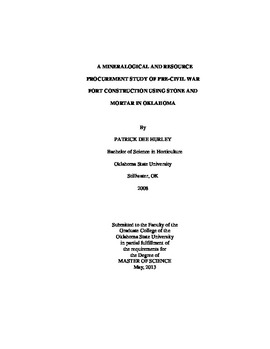| dc.description.abstract | Much is known about the arduous lifestyles of the early nineteenth century United States soldier. However, little is known of the actual laborious fort construction methods these soldiers used as they upgraded from lumber-only to stone-mortar and lumber structures along the western frontier. Specifically, little is known about the mortar production from; natural limestone formations, the process of mortar-stone construction, and of the possible sources for these raw materials. In order to identify how soldiers and workmen produced these mortars, mortar samples were taken from Forts Gibson, Towson, and Washita in eastern Oklahoma. These forts were constructed in 1824, 1824 again in 1831, and 1840 respectively. Each mortar sample was analyzed using thin section analysis, x-ray diffraction (XRD) analysis; calcium carbonate equivalents (CCE) analysis, and total inorganic carbon content. Historical documents were also used to find evidence of possible mortar-production procedures or locations for raw materials. Results indicated that the limestones used in the mortar production were selected based on their natural impurities, most likely for high silica content. The calcium carbonate and silica content were used to ascertain the best mortar composition when producing mortar at or near the fort. Workers needed limestone that yielded a minimum of 60% CCE. Dolomitic limestone would be preferable over pure calcitic limestone. However, Forts Gibson and Towson contained magnesium calcite. Magnesium calcite is stronger than pure calcite, thus more durable and suitable for construction. Thin section analysis showed particle size and ratios for grain, mortar, and void space. Each fort had a mean relationship of 50% grain, 43% mortar, and 7% void space. The grain size used for mortar production measured between .35 and .39 mm. Of those grains, 93.72% were identified as quartz (sand). Though no formal recipe was found while conducting this research, it is possible to re-contruct a period-like mortar from local materials and period methods. | |
